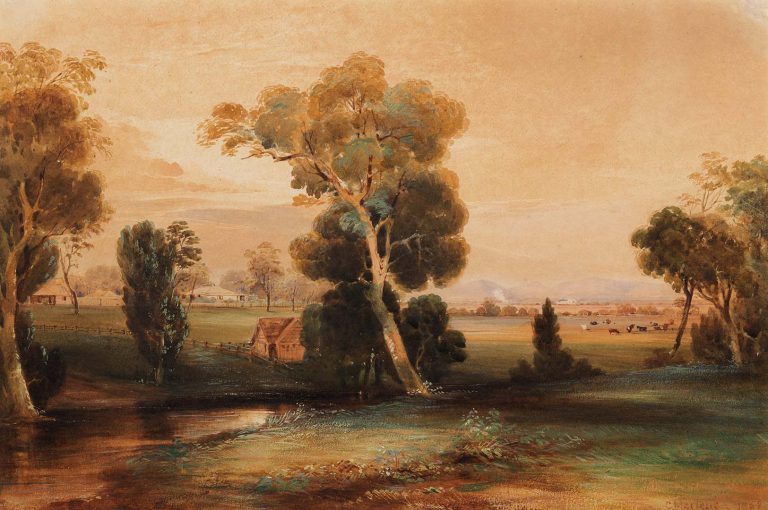We acknowledge the Traditional Owners of the land on which the Queensland Art Gallery | Gallery of Modern Art stands and recognise the creative contribution First Australians make to the art and culture of this country.

Conrad Martens / England/Australia 1801–78 / The homestead, Canning Downs 1852 / 30.1 x 45.5cm / Watercolour / Purchased 1998 with funds raised through The Conrad Martens Queensland Art Gallery Foundation Appeal and with the assistance of the Queensland Government’s special Centenary Fund / Collection: Queensland Art Gallery
Conrad MartensThe homestead, Canning Downs 1854
Not Currently on Display
This view of the homestead at Canning Downs served two purposes: recording the home of a gentleman, and celebrating the achievement of establishing a property in territory not previously settled by Europeans. However modest the dwelling, or strenuous the squatter’s life, documenting his property was essential to the enterprise.
For several months in late 1851 and early 1852, Martens journeyed through the rich pastoral lands of the Darling Downs, travelling on horseback from station to station, sketching as he went. Twice during this time he visited Canning Downs, the home of his friends George and Emmeline Leslie.
This painting shows the fence around Emmeline’s cherished garden, the 1846 homestead, and the original slab hut; a woolshed and a boiling-down works can be seen in the distance. Many buildings pictured here remain on Canning Downs today, if considerably altered. When ill health forced George Leslie to sell the property and return to Britain, Martens used his sketches and watercolours of Canning Downs to paint commissioned landscapes in memory of the Leslie’s life in Australia.
Conrad Martens was born at Crutched Friars, near the Tower of London, in 1801, to a German father and English mother. At the age of 16, he became a pupil of English landscape painter Anthony Vandyke Copley Fielding.
After working as a topographical artist on the Hyacinth, in 1833 Martens met Robert FitzRoy, captain of the British vessel HMS Beagle, and FitzRoy engaged him as the ship’s artist. During the voyage, Martens established an enduring friendship with famous naturalist Charles Darwin. The artist later disembarked in Chile and made his own way to Australia via Tahiti.
Settling in New South Wales in 1835, Martens achieved immediate and enduring recognition as the most proficient and prolific landscape artist in the Australian colonies. He sailed north to Brisbane in late 1851, where he received many commissions, travelling through the Darling Downs at a time of early European settlement in the region.
In the early 1860s, Conrad Martens took a position at the Parliamentary Library to make ends meet, and while this curtailed the time he could spend on his art, he was commissioned for two major public works and also entered the Paris International Exhibition in 1867. He continued to paint until a few days before his death in 1878.
Endnotes:
See Elizabeth Ellis, ‘The life of Conrad Martens’, Queensland Visual Arts Online, Queensland Art Gallery, Brisbane, accessed online 27 April 2017.